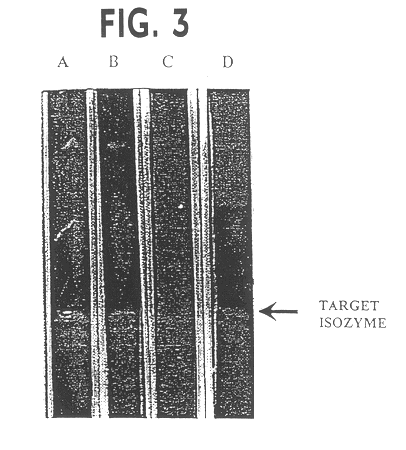Isozyme of autoclavable superoxide dismutase (SOD), a process for the identification and extraction of the SOD in cosmetic, food and pharmaceutical compositions
a technology of autoclavable superoxide dismutase and isozyme, which is applied in the direction of enzymology, peptide/protein ingredients, chewing gum, etc., can solve the problem that the prior art procedures for sod purification do not ensure the elimination of all associated proteins
- Summary
- Abstract
- Description
- Claims
- Application Information
AI Technical Summary
Benefits of technology
Problems solved by technology
Method used
Image
Examples
example 2
Effect of Temperature on Crude SOD Activity
The crude enzyme was assayed at temperatures ranging between -10 to 95.degree. C. in the buffer composition as described in Example 1 except that 50% glycerol was added in the reaction mixture to avoid freezing at low temperature. A glass beaker of 100 ml capacity was filled with either alcohol (for working at temperatures of -10, -5, 0.degree. C.) or distilled water (for working at rest of the temperatures) was used to maintain the temperature of the reaction medium while assaying SOD. Reaction medium along with the enzyme was pre-equilibrated at desired temperature to avoid time lag in attaining the required temperature. As can be seen from FIG. 2 that the enzyme showed highest activity (72.9% inhibition) at 0.degree. C. Yet, another novel finding was that the enzyme was functional even upto -10.degree. C. (41.4% inhibition). The applicants feel that the enzyme will be functional even at temperatures below -10.degree. C. When assayed at u...
example 3
Effect of Boiling and Autoclaving on Crude SOD Activity
To study the thermostability of the enzyme, the crude enzyme was boiled at 100.degree. C. for 60 minutes, cooled down either slowly by leaving at room temperature or by immediate cooling by placing on ice and assayed as mentioned in earlier Example 2 at -10 to 95.degree. C.
A comparison of the enzyme activity before and after the boiling showed that the activity of the enzyme was sustained without any loss (See Table 1).
A rigorous test on thermostability was performed by autoclaving the crude enzyme and then performing assay at -10 to 80.degree. C. As is evident from Table 1 that the activity of the enzyme was sustained with 12 to 35% loss at different temperatures.
example 4
Method of Identification of the Target Isozyme of the SOD for the Purpose of Purification
The above Examples 2 and 3 are suggestive of novel SOD not described hitherto. Hence, it was essential to know if all the isozymes or any one of them depicts the above mentioned properties. A method was, therefore, developed to monitor the activity of various isozymes between sub-zero to +60.degree. C. The isozymes showing good activity at these temperatures was targeted for the purpose of purification and tested for autoclavability. Since crude extract shows the SOD activity after autoclaving, it was contemplated that any isozyme showing prominent activity at this temperature amplitude should show the property of autoclavability as well.
To achieve this:
(a) various isozymes of SOD in the crude extract of the leaf were localized on 10% native polyacrylamide gel as described by Beauchamp and Fridovich (Anal. Biochem. 1971. 44,276-287).
(b) After electrophoresis, gel was rinsed with distilled water ...
PUM
| Property | Measurement | Unit |
|---|---|---|
| temperature | aaaaa | aaaaa |
| melting point | aaaaa | aaaaa |
| temperatures | aaaaa | aaaaa |
Abstract
Description
Claims
Application Information
 Login to View More
Login to View More - R&D
- Intellectual Property
- Life Sciences
- Materials
- Tech Scout
- Unparalleled Data Quality
- Higher Quality Content
- 60% Fewer Hallucinations
Browse by: Latest US Patents, China's latest patents, Technical Efficacy Thesaurus, Application Domain, Technology Topic, Popular Technical Reports.
© 2025 PatSnap. All rights reserved.Legal|Privacy policy|Modern Slavery Act Transparency Statement|Sitemap|About US| Contact US: help@patsnap.com



